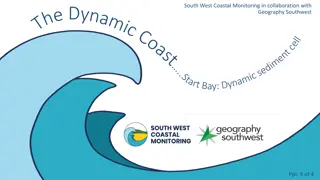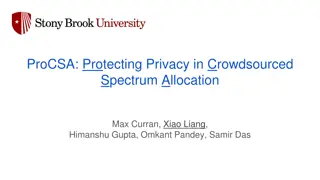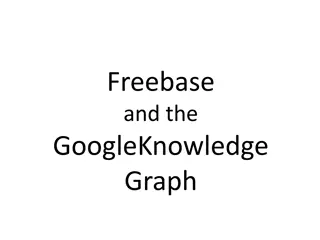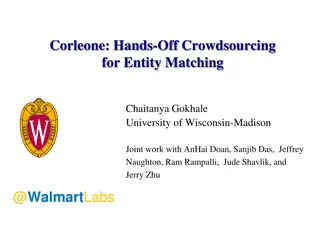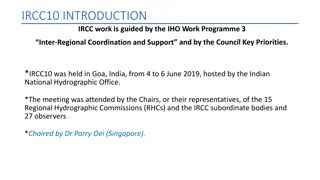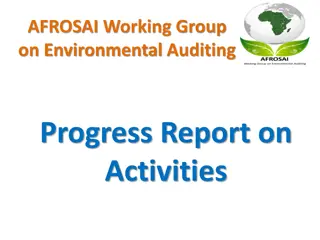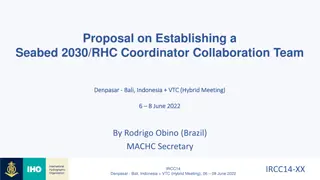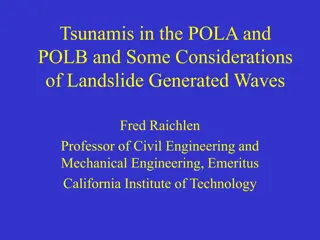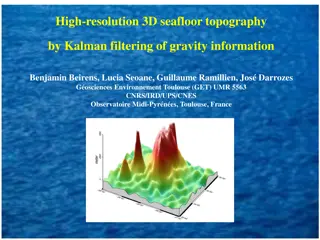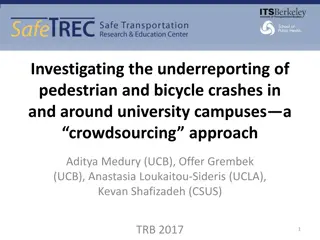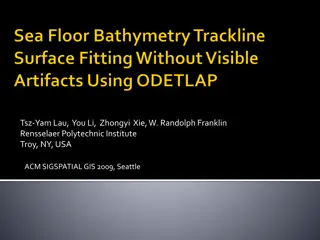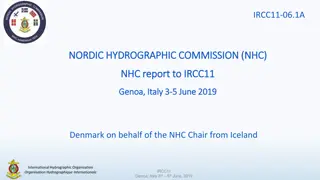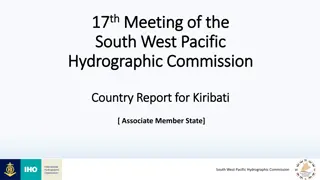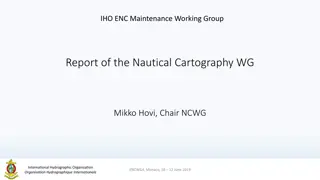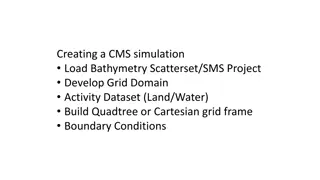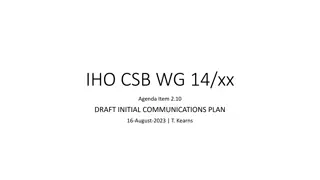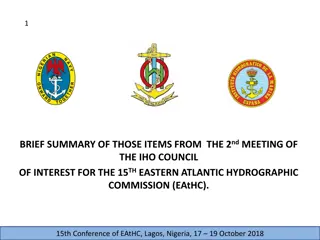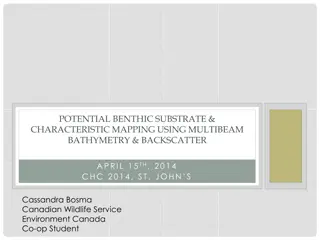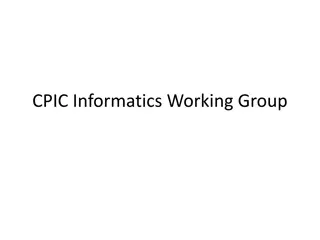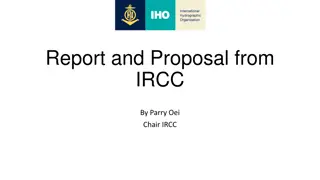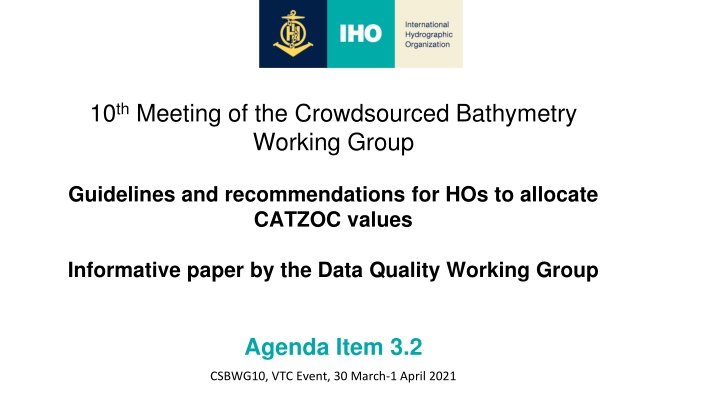
Crowdsourced Bathymetry Working Group Guidelines
This document outlines recommendations for Hydrographic Offices (HOs) to allocate CATZOC values in nautical cartography. It discusses data quality aspects, including the development of checklists and review of product specifications, to ensure harmonized quality standards. The working group also addresses the importance of data quality assessments and best practices for using crowdsourced bathymetric (CSB) data on official charts, aiming to enhance safety of navigation and data accuracy.
Download Presentation

Please find below an Image/Link to download the presentation.
The content on the website is provided AS IS for your information and personal use only. It may not be sold, licensed, or shared on other websites without obtaining consent from the author. If you encounter any issues during the download, it is possible that the publisher has removed the file from their server.
You are allowed to download the files provided on this website for personal or commercial use, subject to the condition that they are used lawfully. All files are the property of their respective owners.
The content on the website is provided AS IS for your information and personal use only. It may not be sold, licensed, or shared on other websites without obtaining consent from the author.
E N D
Presentation Transcript
10th Meeting of the Crowdsourced Bathymetry Working Group Guidelines and recommendations for HOs to allocate CATZOC values Informative paper by the Data Quality Working Group Agenda Item 3.2 CSBWG10, VTC Event, 30 March-1 April 2021
DQWG TERMS OF REFERENCE 1. Objective: to ensure that the data quality aspects are addressed in an appropriate and harmonized way for all S-100 based product specifications. 2. Should: - develop/maintain DQ checklist. - review S-100 based PS for DQ aspects. - monitor international standards (e.g. ISO-19157). - provide guidance to HOs on DQ aspects. - provide educational material (S-67). - review methodology to display quality information. - propose new topics (e.g. autonomous shipping).
CSBWG REQUEST FOR GUIDANCE The IHO CSBWG requests guidance on the usage of CSB data on official nautical charts, specifically on the importance of data quality assessments and general good practices by HO s from the DQWG. A DQWG white paper on CSB data usage by MSs could provide useful advice for HO s about the possibility to use CSB as a resource. The result of a DQWG analysis, endorsed by the DQWG, could be forwarded to the CSBWG for further discussion on how best to disseminate to HO s and other WGs.
DISCUSSED AT DQWG16 (FEB 2021) Topic was addressed in addition to the work item in progress to develop guidelines and recommendations to HO s based on best practices to allocate CATZOC values. DQWG Chair attended TWCWG5 (online) and approached HSWG Chair. Both TWCWG Chair and HSWG confirmed their active involvement. Initial draft paper is made available to S-101PT, S-102PT, TWCWG, HSWG and CSBWG (informative). Result of subWG to be presented at DQWG17 (Feb 2022).
RELATED DOCUMENTS / STANDARDS 1. S-4 Edition 4.8.0 2. S-44 Edition 6.0.0 3. S-57 Appendix B.1, Annex A (UOC) Ed.4.2.0 4. S-67 Edition 1.0.0 5. S-101 Data Classification Encoding Guide Ed.1.0.1 6. S-102 Edition 2.0 7. B-12 Guidance on Crowdsourced Bathymetry 8. C-51 Manual of Technical Aspects on Law of the Sea 9. INSPIRE D2.8.II.1 Data Specification on Elevation
FROM PING TO CHART (SURVEY TO CATZOC) 1. Data capture, associated accuracy (S-44). 2. Data storage (vector format S-57 or S-101). 3. Data storage (grid format S-102). 4. Data quality measures and recommended target results. 5. Assigning appropriate CATZOC values. 6. Added value of CSB data.
S-44 DATA CAPTURE IHO S-44 classification of safety of navigation surveys Order Characteristics Intended Usage General bottom depiction. Areas > 200 m. Low risk for navigation. 2 General bottom depiction. Areas where UKC is not an issue. 1b Adequate bottom depiction, 100% feature search. Full bathymetric coverage and feature detection. 200% bathymetric coverage and feature search. Coastal waters, harbours, berthing areas, fairways and channels. 1a Areas where UKC is critical. Special Shallow water areas with exceptional and optimal use of the water column. Exclusive
DATA STORAGE VECTOR FORMAT Electronic Navigational Chart according to IHO Standard S-57 Combination of depth contour lines (describing the sea bottom morphology) and soundings (showing the point of least depth in an area). Standard contour lines at 0, 2, 5, 10, 20, 30, 50, 100, 200, 300, 400, 500, 1000, 2000, etc.1 Supplementary contours at 3, 8, 15, 25, 40, 75m and multiples of 10 or 100 may be shown.2 1,2IHO Standard S-4 art. B-411
DATA STORAGE GRID FORMAT S-102 Bathymetric Surface Product Specification (Ed.2.0.0 Oct 2019). Bathymetric coverage (feature type) that consists of depth and uncertainty (both simple attributes) Bare surface of the seafloor = digital terrain model (DTM) Including heights of objects present on the surface = digital surface model (DSM). Ground Sampling Distance (GSD) = indication of external accuracy. (max RMSEv= GSD / 3)
DEPTH DISCONTINUITIES BETWEEN SURVEYS May be caused by1: Surveys in areas of continually changing depth conducted with a significant time gap between the surveys; or Adjoining areas having significant differences in the quality of bathymetric data (completeness, feature detection, accuracy of survey). Where required to indicate depth discontinuities, a very narrow UNSARE object of at least 0.3mm at ENC compilation scale should be created, populate the INFORM field. 1IHO Publication S-57, UoC par 5.8.4
CONSISTENCY BETWEEN SPATIAL DATA SETS There are three topics regarding consistency between spatial data sets, these are: Coherence between spatial objects of the same theme at different levels of detail. Coherence between different spatial objects within the same area. Coherence at State (maritime) boundaries.
SELF-CONSISTENCY OF ELEVATION (DEPTH) DATA Elevation data in the different spatial representation types should maintain integrity and positional consistency, at least when coming from the same data provider. S-101 contours/soundings should match S-102 grid data. S-101 accuracy values should match S-102 accuracy values (i.e. the accuracy associated with a sounding, should have the same value as an S-102 node at that exact same location).
ADDED VALUE OF CSB DATA Data capture by official (hydrographic) surveys are done to capture the shape of the seabed and process this data into an official nautical chart. The captured data is validated against acquisition standards (S-44), then Product Specification (S-57) and User requirement (guaranteed use in certified ECDIS equipment by trained and certified user). In order to assess the usefulness of CSB data to the nautical chart, metaquality is recommended to be used.
META QUALITY ELEMENTS Confidence trustworthiness of a data quality result. Representativity degree to which the sample used has produced a result which is representative of the data within the data quality scope. Homogeneity expected or tested uniformity of the results obtained for a data quality evaluation. Note quantitative figures for confidence can be obtained by statistical parameters such as standard deviation or a confidence interval on a given confidence level.
CSB = NO TIDAL CORRECTION (DEFAULT) tidal range
ACCURACY OF SOUNDINGS IN OFFICIAL NAUTICAL CHARTS CATZOC A1 A2 B C D depth HOR VRT HOR VRT HOR VRT HOR VRT HOR VRT 5.0 m 5.5 m 6.0 m 6.5 m 7.0 m 7.5 m 8.8 m 10.0 m 1.5 m 0.5 m 0.6 m 0.7 m 0.8 m 0.9 m 1.0 m 1.3 m 1.0 m 1.2 m 1.4 m 1.6 m 1.8 m 2.0 m 2.5 m 3.0 m 1.0 m 1.2 m 1.4 m 1.6 m 1.8 m 2.0 m 2.5 m 3.0 m 2.0 m 2.5 m 3.0 m 3.5 m 4.0 m 4.5 m 5.8 m 7.0 m > 2.0 m > 2.5 m > 3.0 m > 3.5 m > 4.0 m > 4.5 m > 5.8 m > 7.0 m > 12.0 m > 17.0 m 0 10 20 30 40 50 75 100 20 m 50 m 500 m > 500m 15.0 m 2.5 m 5.0 m 5.0 m 12.0 m 200 20.0 m 3.5 m 7.0 m 7.0 m 17.0 m 300
ENC COMPILATION SCALES BEYOND TERRITORIAL SEA 12 nm 24 nm 48 nm 96 nm 200 nm
ENC COMPILATION SCALES WITHIN TERRITORIAL SEA 0.25 nm 0.5 nm 0.75 nm 1.5 nm 3 nm 6 nm 12 nm
RECOMMENDED STANDARD ENC COMPILATION SCALES Selectable range 200 NM 96 NM 48 NM 24 NM 12 NM 6 NM 3 NM 1.5 NM 0.75 NM 0.5 NM 0.25 NM Standard scale 1:3.000.000 1:1.500.000 1:700.000 1:350.000 1:180.000 1:90.000 1:45.000 1:22.000 1:12.000 1:8.000 1:4.000 Resolution (pen width)1 900 m 450 m 210 m 105 m 54 m 27 m 13.5 m 6.6 m 3.6 m 2.4 m 1.2 m 1Standard pen width = 0.3 mm
ASSESSMENT OF CSB DATA (STAGE 1) Error source Static draft setting Variation of draft Correct sound speed Sensor offset Tidal correction Meta quality element Confidence Representativity Homogeneity Applied YES / NO / UNKNOWN YES / NO / UNKNOWN YES / NO / UNKNOWN YES / NO / UNKNOWN YES / NO / UNKNOWN Result PASS / FAIL / NOT APPLIED PASS / FAIL / NOT APPLIED PASS / FAIL / NOT APPLIED Confidence level HIGH / MEDIUM / LOW HIGH / MEDIUM / LOW HIGH / MEDIUM / LOW HIGH / MEDIUM / LOW HIGH / MEDIUM / LOW Final assessment for usage in official chart Result PASS / FAIL
ASSESSMENT OF CSB DATA INTO OFFICIAL NAUTICAL CHARTS (PROPOSAL TO BE DISCUSSED) 1. Areas of CATZOC A1 and A2, not to be used (inaccurate CSB position). 2. If accuracy horizontal position < 25m, could be used in zone B. 3. If accuracy horizontal position < 250m, could be used in zone C, D and U. 4. If CD - MSL separation < half the vertical uncertainty at a certain depth, could be used. 5. If chart compilation scale is 1:90.000 or smaller, could be used1. 1Note today the accuracy of standalone positioning with GPS is in the order of 5-15 meters under reasonable satellite visibility.
QUESTIONS? DQWG subWG on CATZOC consists of: Canada, Denmark, France, Netherlands, New Zealand, UK, US, CSMART1, University of New Hampshire. 1Carnival s Center for Simulator Maritime Traning


